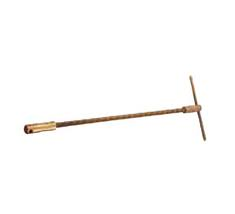
The method of thermal deburring effectively removes the burrs from the inner surface of the parts, but after this treatment the parts are contaminated with metal particles and residues of combustion products from the explosion. This dirt is difficult to remove from parts using conventional cleaning methods, but with the efficient cleaning system we achieve a high level of cleanliness at the lowest cost. You would also be needing the use of the welded rail deburring device here.
The efficient cleaning system includes a combination of different agitation methods that help remove contaminants. Together with optimized cleaning chemicals, you can achieve excellent cleaning results after thermal deburring, and when the process requires high power and a quick cleaning result. Efficient automatic lines can even reach 10 minutes for cleaning after thermal deburring.
Part after TEM
Efficient cleaning technology combined with vertical agitation also makes it possible to clean a variety of components that are difficult to wash. The cleaning process can be adjusted so that it is suitable for both steel and cast iron parts. As a rule, efficient cleaning lines are equipped with corrosion and drying protection stages, with the help of which a sufficient final treatment of the washed parts is achieved.
Efficient cleaning lines can be delivered fully automated, then, for example, the following steps do not require additional work from consumers: re-fill the washing baths, dosage of detergents, refreshing rinsing water, filtering liquids, controlling the functions of the cleaning process and moving components through the entire process.
Energy-Saving Technologies
These are devices in which the saving technologies of developers are incorporated, allowing saving electric energy due to filtering capacitors. The company develops energy saving technologies, provides services for the installation of devices with a 100% guarantee of your savings.
Modern energy-saving technologies

Modern energy-saving technologies can reduce the consumption of electric energy from 20 to 60%. The producing company offers the introduction of FCTF Filtering Capacitor with Current Damping Function, consisting of many parallel-connected LC circuits. This modern energy-saving technology allows you to:
- To increase the service life of electrical equipment, as well as the reliability and safety of use
- Compensate the reactive component cos φ = (0.99 ÷ 1)
- Reduce up to 3 times the starting currents of induction motors
- Reduce the operating temperature of electric motors and electric conductors by 2-3 times
- Increase the efficiency of power consumers by 5%
- Reduce power consumption by an average of 10 ÷ 40%, depending on operating conditions
The use of energy-saving technologies
Energy-saving technologies have found their application in all areas of industry. Basically, energy-saving technologies based on the FCTF are installed on the following equipment:
- Induction motors
- Transformers and electric motors
- Inductive type electrical receivers, electrical networks in general
- Electric melting and welding systems
- Induction melting furnaces
- Arc furnaces
- Electric trains and electric locomotives
- Railway traction substations
- Rectifier installations of direct current networks
- Lightning equipment.
Introduction of energy-saving technologies
The introduction of energy-saving technologies is the need of every enterprise to reduce energy consumption. Filtering capacitors use the principle of current pulse shunting, as well as reactive energy compensation. The energy saving process uses the transitional processes listed above to reduce losses when changing the magnetic induction of electrical equipment during round-the-clock use. FCTF is installed with a capacitance to optimize and limit currents.
The introduction of modern energy-saving technologies of FKTF on induction motors and transformers is carried out by installing many capacitors of parallel circuits assembled on a single board.
